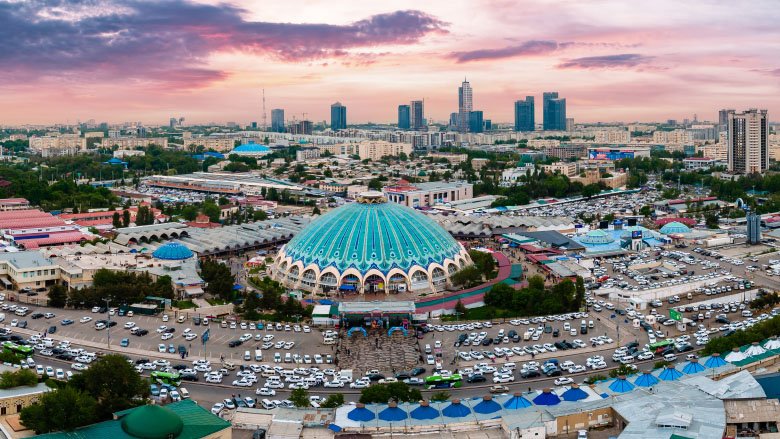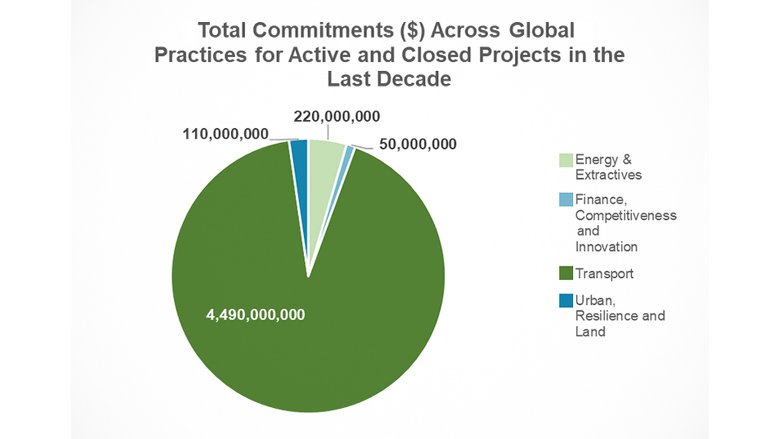Key Highlights
- Increased electricity trade among Central Asian countries could conservatively generate economic benefits of up to $6.4 billion between 2020 and 2030.
- $3.5 billion in net commitments have been distributed across 7 active regional integration projects in Central Asia.
- Estimated costs from insufficient cooperation in use of regional water-energy resources amount to more than $4.5 billion per year.
- Since 2014, the Climate Adaptation and Mitigation Program for Aral Sea Basin (CAMP4ASB) has reached nearly 135,000 beneficiaries, of whom 27 percent are female beneficiaries, with the creation of over 27,500 jobs.
- CAWEP has facilitated 23 water, energy, and environmental investments worth approximately $3.78 billion since the start of the program in 2009.
- Since 2010, 1.2 million people directly benefited from a road rehabilitation project in Kyrgyz Republic.
- The cargo transportation along the Western Europe – Western China road corridor reduced from 45 days to 8-10 days thanks to the Kazakhstan - East West Roads Project.
Challenge: Regional Co-ordination is a Development Opportunity
Despite recent moves toward building greater interconnectedness, the countries of Central Asia (CA) - Kazakhstan, Kyrgyz Republic, Tajikistan, Turkmenistan, and Uzbekistan - remain some of the least connected economies in the world, with the region’s connectivity indicator averaging below a 60 percent ratio of access to global GDP. CA countries also rank among the most climate change-vulnerable in the Europe and Central Asia (ECA) region. Energy and water is a particular challenge, exacerbated by a range of factors, including climate change, population growth, and economic development. While steps have been taken towards more efficient regional energy markets, their weakness will continue to hinder economic growth and negatively impact livelihoods and standards of living.
Regional integration benefits arise from trade between countries that share complementary energy resources – for example hydropower in the Kyrgyz Republic and Tajikistan, large renewable energy potential and flexible fossil fuels in Kazakhstan, Turkmenistan and Uzbekistan. The region is unique in its very close interlinkages between water, energy, and land systems, requiring the coordinated use of transboundary water resources. Recent studies estimate the costs from insufficient cooperation in use of regional water-energy resources amount to more than $4.5 billion per year; regional electricity trade is currently at around 2.5 percent of regional demand. Another issue is employment: according to the International Labor Organization in 2019 the CA region experienced a 13 percent labor underutilization composite rate - an issue which could be addressed by Increased regional market efficiency. Finally, even post-COVID, CA is particularly vulnerable to infectious disease outbreaks – both human and animal - as it is located at an intersection of global value chains with countries that rely heavily on labor migration.
Approach: Building a Platform for Co-operation
Recent power system modelling analysis for Central Asia shows that the region can conservatively exploit economic benefits of up to $6.4 billion through enhanced regional energy trade during 2020-2030. A commitment is needed to start developing short-term economic trade mechanisms to complement predominant long-term bilateral import/export arrangements. The World Bank works with the Central Asian countries to improve the connections between countries in the areas of water and energy, trade and logistics, climate change mitigation and adaptation, information and communications technology, and healthcare and pandemic response. One of the main pillars of the World Bank Regional Engagement Framework for CA is to support regional energy connectivity and trade.
A regional electricity market that draws on a diverse energy mix, including hydropower and other renewable sources, can strengthen supply, boost domestic and regional economic growth, and support decarbonization. In particular, the World Bank is working with Central Asian governments to scale up energy interconnectivity through a mix of investments, technical assistance, advisory services and analytics (ASA), and capacity-building activities. A key feature of this initiative is a proposed pilot for a day-ahead market that would provide a template for a more permanent solution. The pilot will demonstrate proof of concept, while encouraging cooperation that balances different levels of domestic market development.
Results: Cross-Sectoral Collaboration across Borders
The World Bank has supported cooperation between the Central Asian countries in the regional management of electricity and water resources. The impact of climate change across Kazakhstan, the Kyrgyz Republic, Tajikistan, Turkmenistan, and Uzbekistan could drastically impact water availability, threatening these countries’ food security, curtailing hydropower generation and impeding the large-scale deployment of renewable energy sources. Aging Soviet-era infrastructure across Central Asia makes the delivery of water services excessively energy-intensive. Hydropower contributes to over 80 to 90 percent of total electricity production in Kyrgyz Republic and Tajikistan, but less than 5 to 10 percent of their full hydro-power potential is currently exploited. Meanwhile, Uzbekistan, Turkmenistan and Kazakhstan rely on fossil fuels for 80 to 100 percent of their energy requirements, leaving significant scope for decarbonization. Addressing the water-energy nexus is crucial for fighting climate change across Central Asia and ensuring a resilient, sustainable, prosperous future for the region. It will require an integrated approach based on regional collaboration and cross-sectoral coordination.
Since 2009, the Central Asia Water and Energy Program (CAWEP), a joint program supported by the European Union, Switzerland, the United Kingdom, and USAID, and managed by the World Bank, has been supporting regional cooperation and integration for strengthening water and energy security. Since the start of the program, it has facilitated 23 water, energy, and environmental investments of $3.78 billion, assisted sector reforms, systems modernization, regional dialogue, and institutional strengthening for key regional organizations. The third phase of the program, which ends in November 2023, catalyzed almost $1.6 billion in new Bank-funded water and energy investments, convening many technical knowledge exchanges, and providing technical assistance to build sector capacity for more than 25 national institutions. It contributed significantly to the development of an integrated regional hydrological and meteorological data processing and forecasting platform – Central Asia Flood and Early Warning System (CAFEWS), which will improve regional monitoring and forecasting of extreme weather and other risks, assist in disaster preparedness, and support the management of water resources and the optimization of agricultural and energy production. The ambitious fourth phase of the program (CAWEP-4) will promote regional cooperation for more resilient and better-integrated water and energy management under a changing climate.
The Bank-organized Central Asia Energy Trade and Investment Forum that took place in London in March 2023 convened policymakers from Kazakhstan, Kyrgyz Republic, Tajikistan and Uzbekistan, as well as representatives of international financial institutions and the private sector to discuss the interlinked challenges of energy security, decarbonization, and economic growth. The event, co-hosted with Central Asian governments and the government of the United Kingdom, secured political commitment from Central Asian governments for regional energy integration, and identified the proposed Bank project on Central Asia – Regional Electricity Market Interconnectivity and Trade Project (REMIT), currently under preparation.
The five countries of Central Asia are among those most vulnerable to climate change in Eurasia; improving resilience to growing climate impacts as a means of reducing poverty is a top priority in the region. The Climate Adaptation and Mitigation Program for Aral Sea Basin (CAMP4ASB) addresses common problems and challenges related to climate change in Central Asian countries by enhancing access to improved climate change knowledge and data for key stakeholders; and by increasing investment and capacity building. CAMP4ASB is financed by the International Development Association (IDA) and the Green Climate Fund (GCF).
The implementation of various sustainable land management (SLM) measures, including the use of efficient irrigation systems, cultivation of high-value crops, and improved livestock breeding resulted in income increases of 30 to 79 percent for over 10,000 farmers in Uzbekistan and Tajikistan. The measures facilitated access to economic resources for the poor and vulnerable, particularly previously displaced individuals and women. This was accomplished through the creation of 910 new family farms, restoring a total abandoned land area of 354,200 hectares, which generated employment opportunities for 17,500 seasonal workers from neighboring regions, and 6,114 permanent positions. Additionally, 4,131 local residents, mostly women, were recruited to work in forest nurseries and land restoration projects.
Healthcare and pandemic prevention, preparedness, and response are other areas of regional concern. In the first three months of the COVID-19 outbreak, the World Bank committed $1.3 billion in financing to the region to mitigate the impacts of COVID-related challenges. It supplied 700 ventilators to hospitals in Kazakhstan.7 In Uzbekistan, the funding helped the government reach an additional 135,000 low-income households with social protection programs. Post-pandemic, the focus is on developing and implementing the Central Asia One Health Framework for Action, aimed at providing direction and coordination mechanisms for regional cooperation to address needs in the areas of zoonotic diseases, antimicrobial resistance, and food safety. According to a World Bank analysis, annual investments of $1.9 to $3.4 billion in One Health systems (based on disease prevalence) by the international community could generate a 44-71 percent annual expected rate of return and reduce mild pandemics by half or prevent them entirely.
The joint application of Central Asian countries for a $27.16 million grant, led by the World Bank and the Quadripartite Alliance for One Health (including the Food and Agriculture Organization of the United Nations, United Nations Environment Programme, World Health Organization and World Organisation for Animal Health) , was among the 19 projects selected by the Pandemic Fund’s Governing Board under its first round of funding allocations for boosting countries’ resilience to future pandemics. The grant resources would support the regional One Health Project, currently under preparation and to be delivered in FY25.
Data Highlights
Partnerships: A Cross-border Network for Economic Growth
The World Bank institutions work with a diverse range of partners to achieve goals related to regional co-ordination in Central Asia. For example, the Bank is resetting its engagement with the Central Asia Regional Economic Cooperation (CAREC) Program to improve cooperation with developments partners like the Asian Development Bank (ADB) in delivering results for the Client Member Countries—Afghanistan, Azerbaijan, the People's Republic of China, Georgia, Kazakhstan, the Kyrgyz Republic, Mongolia, Pakistan, Tajikistan, Turkmenistan, and Uzbekistan - especially on projects related to energy and transport connectivity. The European Union, Switzerland, and the United Kingdom have been cooperating with the Bank for almost 14 years under CAWEP and will continue this engagement for the next 5 years under the fourth phase of the program. The other development partners are the European Bank for Reconstruction and Development (EBRD), International Monetary Fund (IMF), Islamic Development Bank (IDB), USAID and the United Nations Development Program (UNDP). The World Bank is also working with the Asian Infrastructure Investment Bank (AIIB), European Investment Bank (EIB), Islamic Development Bank (IsDB) and other development partners to provide parallel financing for low-income CA countries on renewable energy projects, including construction of the Rogun hydropower station in Tajikistan, the largest regional clean infrastructure investment project supported by international financial institutions (IFIs). The World Bank will continue to collaborate with the Quadripartite Alliance for One Health and other development partners to support Pandemic prevention, preparedness and response and food system resilience through a One Health approach.
Looking Ahead: A Shared Regional Vision
The World Bank recently marked the 30th anniversary of its engagement in Central Asia. Over this period, the Bank has supported the efforts of the countries to improve the living standards of their people, promote economic growth, and ensure that future generations benefit from sound environmental practices and social development. The countries of Central Asia share more than just borders; they also share a similar legacy and, more importantly, a common vision for the future. The World Bank is increasingly approaching the development challenges of Central Asian countries through a regional lens; while focusing on medium-term country outcomes, the Bank is also expanding innovative engagements addressing both global and regional challenges.

